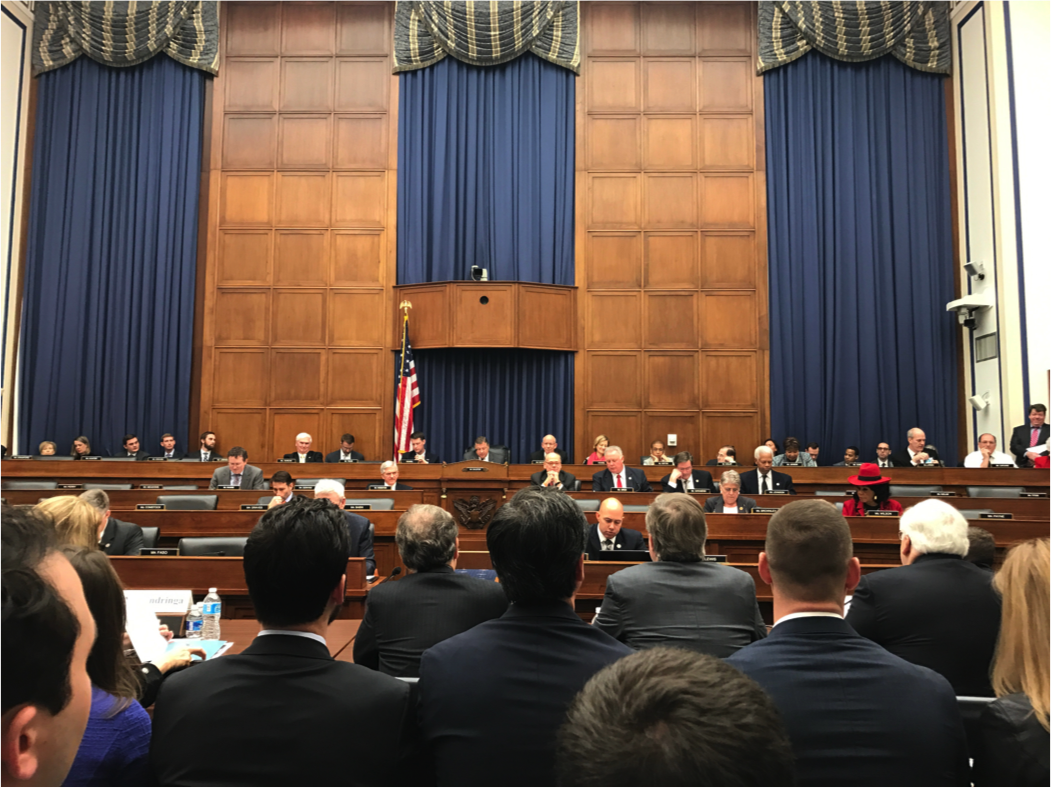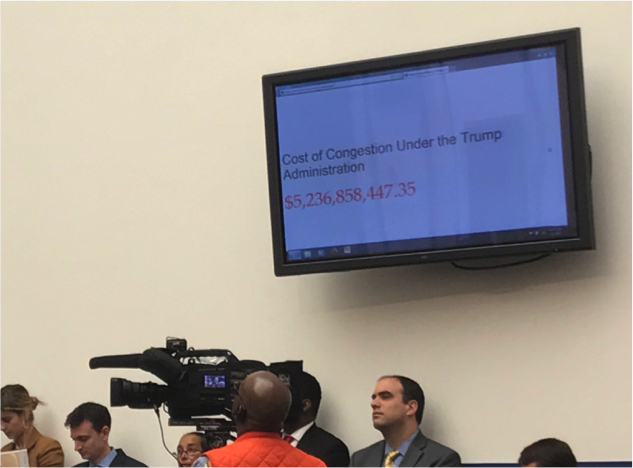February 2, 2017
At the 21st Century Transportation Infrastructure Symposium, a senior Member of Congress called for a paradigm shift in our national approach to mobility:
“If our current approach to solving congestion, pollution, and 40,000 highway deaths a year – pouring more concrete and more asphalt – sounds like slugging away at a problem rather than solving it, then it’s time for an intelligent approach to the future of transportation: an Intelligent Transportation System.”
While it is likely a similar speech has already been made at a similar event this year, the late Congressman Jim Oberstar gave these remarks at the 1997 symposium – a time when the nation was looking forward to the possibilities of a new millennium.
Two decades later – and 17 years into the 21st Century – the House Transportation and Infrastructure Committee (T&I) held a hearing titled Building a 21st Century Infrastructure for America. (Video of the hearing can be viewed here.)
Which begs the question: what makes a transportation network actually befitting its century, of 100 years of technological developments, fluctuating policies, economic booms and busts?
Regardless, it seems Americans have 80 more years to build infrastructure befitting of this century before the conversation shifts to 22nd Century.
This was the first full T&I committee hearing of the 115th Congress, a three-hour marathon of questions for a panel of four business executives and one labor leader.
Throughout their testimonies, four key issues stood out: emerging technologies, infrastructure funding, and trade.
In his opening remarks, Chairman Bill Shuster (R-PA) called for the privatization of air traffic control, integration of emerging technologies like autonomous vehicles and drones, and repairing and modernizing America’s transportation infrastructure.
“Thank you Mr. Chairman, I very much share the sentiments you expressed. I was interested to learn that the first earmarked highway project in America runs through your district,” teased Ranking Member Peter DeFazio (D-OR) as he began his opening statement.
“It wasn’t my father,” Shuster chuckled.
DeFazio launched into a fiery opening statement, challenging members to be bold in improving America’s highways, waterways, and airports. “We are frozen in amber, we are refusing to invest in our infrastructure. Yeah, the FAST Act was good, but part of it’s paid for with funny money that will never show up because we didn’t have the guts here to increase user fees.”
DeFazio outlined a three-point plan to rebuild America:
- Index the gas tax and issue bonds
- End the diversion of funds from the Highway Maintenance Trust Fund
- Lift the cap on Passenger Facility Charges (PFCs) for airports
Adding fuel to the fire, DeFazio showed the committee the congestion clock on the committee minority’s website, which quantifies the cost of congestion since the day President Trump was inaugurated.
The witness list was notably missing the other players in the transportation field, 21st Century or otherwise: transit agencies, cities, state DOTs, airports, cyclists, technology companies, and many others were left out of the panel – in fact, many of those groups were rarely mentioned.
The 21st Century panel was comprised of representatives from companies founded in the 20th Century:
- Mr. Frederick W. Smith, Chairman and Chief Executive Officer of the FedEx Corporation | Written Testimony
- Mr. David W. MacLennan, Chairman and Chief Executive Officer of Cargill, Incorporated | Written Testimony
- Mr. Ludwig Willisch, President and Chief Executive Officer of BMW of North America | Written Testimony
- Ms. Mary V. Andringa, Chair of the Board of the Vermeer Corporation | Written Testimony
- Mr. Richard L. Trumka, President of the AFL-CIO | Written Testimony
Infrastructure Funding
“It’s time to confront these issues,” DeFazio said in his opening statement. “The American people get it – a number of all-red states have raised their gas tax. Nobody has been recalled or lost their election.”
DeFazio called for indexing the gas tax to construction cost inflation and fleet fuel economy, estimating that gas would increase only by 1.2 cents per gallon over the next year.
He projected that, if this is done across the next 30 years, the government could issue 30-year tranched bonds- yielding $500 billion. DeFazio says this would add $23 billion additional per year in revenue, make the highway trust fund whole across the next three authorizations, and bring the nation’s infrastructure to a state of good repairs in the next 14 years.
For their part, Fred Smith of FedEx and Richard Trumka of the AFL-CIO also agreed that the gas tax should be increased.
At the beginning of the hearing, Shuster submitted to the record a letter from 40 business leaders to President Trump encouraging him to make investments across every mode of transportation. This touched on a key, critical theme that will play out across this year’s infrastructure debate:
“Private financing, while important and needed, cannot replace the role of public funding and federal leadership.”
When asked by Congressman Mike Capuano (D-NY), every panelist agreed that public-private partnerships were a useful – yet limited – tool for funding infrastructure projects.
Buy American, Hire American
Throughout the hearing, AFL-CIO President Richard Trumka emphasized his support for ensuring that the federal government invests in American jobs, American products, and American-built infrastructure.
In other words: Buy American, Hire American.
Representatives Rick Larsen (D-WA), Dina Titus (D-NV), and Dan Lipinski (D-IL) stood out as the largest supporters of Buy American, Hire American provisions throughout the hearing as well.
(Ed. note: Expect Lipinski to introduce a “Buy America” transparency bill next week – he mentioned that he will be introducing a bill next week to close the loopholes.)
Emerging Technology
Autonomous vehicles – the one topic that both parties can (mostly) agree on – were mentioned throughout the hearing.
Lately, automakers and tech firms have been asking government officials to do only one thing to help prepare for a future with autonomous vehicles: keep roads in a state of good repair.
This is because there are two divergent lines of thought on the future of autonomous vehicles: that they will need to also be connected with other vehicles and infrastructure, or that they will operate fully autonomously without the need for external input.
At this point it remains unclear which side will prevail, in part because (a) manufacturers must first choose whether they want their autonomous vehicles to be connected to potentially vulnerable infrastructure networks, and (b) even if automakers choose to introduce connected features in their vehicles, their full benefits cannot be realized until consumers purchase enough of them to saturate the market.
In particular, states and local governments must ensure that lane markings are clear and standardized rather than investing in costly connected infrastructure.
Ludwig Willisch of BMW was forced to make this statement as many as five times as Members of Congress continued to ask if any additional infrastructure is needed, to the point where he repeated just two phrases when he was asked “clear lane markings” and “no pot holes.”
David MacLennan of Cargill reinforced this point:
“As exciting as new technologies are, we should also think about our traditional assets. So the remainder of my testimony will focus not on the shiny objects, but on the ones that tend to get rusty: the rails, roads, bridges and waterways of rural America.”
Meanwhile, Congresswoman Bernice Johnson (D-TX) expressed grave concerns that autonomous vehicles and other forms of automation would eliminate jobs. She chided FedEx and BMW for their interest in autonomous vehicle technologies and automated manufacturing – to which they both replied that automation has created high-paying jobs and increased efficiency.
Dive Deeper:





